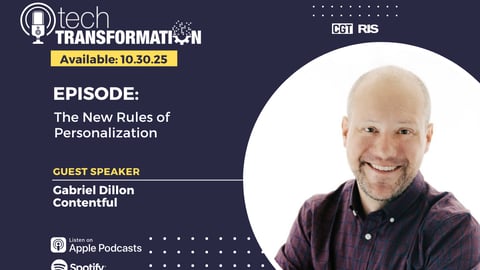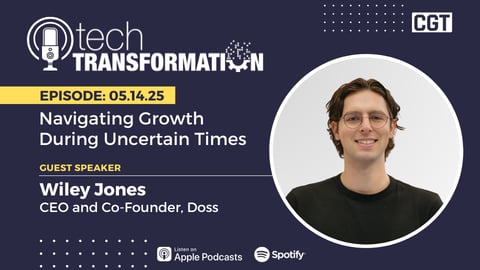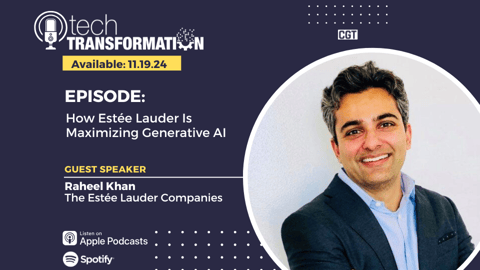PepsiCo’s Mark Kirkham On New Data Partnerships
As consumer goods manufacturers and retailers rethink how they collect and leverage consumer data, it has them reinventing their external partnerships. PepsiCo is not only entering first-of-its-kind relationships with companies like Spotify and EA Sports, but it’s also looking ahead to how it might use the data to drive further value at retail and for its retail partners. In this episode of Tech Transformation, we’re talking with Mark Kirkham, SVP and CMO of PepsiCo’s international beverages business, about some of the new ways they’re collecting data, how their partnerships are driving value well beyond brand awareness, and some of the technologies that are connecting the dots.
Listen to learn:
- Why PepsiCo is forming and expanding partnerships with organizations like Spotify, EA Sports, and UEFA
- How these partnerships deliver value to PepsiCo’s retail partners
- How they’re leveraging consumer insights in new ways
- How they’re tracking progress, tying it back to marketing, and the metrics they use
- How they’re using these insights elsewhere
- Some of the ways they’re leveraging technology to ensure experiences are personalized and authentic
- How they navigate the expectations of hyper-personalization as a large global company
- What’s next for tech-driven experiences at PepsiCo
Subscribe
Excerpts
On teaming with Spotify: “We learned a lot about data, a lot about engagement, a lot about how long people can stay engaged in kind of longer-form content. … For us, it's a brand new technology, it's a very immersive and growing space with downloadable and streaming music, and also a great way to engage fans with our brand. It's not just a banner ad; it's not just a visibility play, or an awareness play. It's a fundamental brand engagement play. We want to make our brand relevant to them through platforms that are relevant to them through passions that are relevant to them. And that's where Spotify was a perfect example. And a great way to show innovation, but also just a way to do things differently, versus just creating an ad with an artist or just buying a track and using it in your communication.”
On how these partnerships drive value to retailers: “We're leveraging some of our own capabilities, which are actually looking at perfect store and personalization at scale. And how do we leverage store-level data to target most valuable stores, and work with our retail partners to actually drive traffic.
“We've done different tests to look at the right level of signage, the right level of promotion, and using that store-level detail and actually creating perfect store universes to understand where we have the most. Whether it's the interchanging category, or partnerships, even within our own portfolio across food and beverage, how can we increase basket size. So by using just simply a promotional mechanic with Spotify, and our own data and our own analytics and be able to target perfect stores, we can elevate that experience for both the retailer and for the consumer.”
On how data is evolving: “I think what's the most important thing that's different is I think data has evolved beyond transaction. I think too often in the past, we relied on data to tell us what happened in the past. And on a transactional level, what we need is to find a way to share data.
“And look, sharing data is not always easy. Everyone has their own proprietary data. But I think if you find the right ways to partner with your retailers with your third parties, to share data to actually really surround the consumer, with your brands from a retail and from a manufacturer standpoint, this ability to share will allow us to not only see what they bought, but what are they interested in? What did they buy last time? What are the things? What are the other categories they're engaging? You know, how do you tie it in through other subscriptions, other services.
“This is when you take a mobile platform like Spotify, to an in-store activation platform just like a regular POS, and then take it to the next level with actually integrated into the stagers platform, where they can actually be interacting with a point of sale and outdoor signage, a bus shelter, six sheet, all of these interconnected points create data.
“If you can find the right mix of retail partner, in this case, Spotify and brand, I think what you can do is no longer focus on just that end transaction, but the ecosystem in which you can engage both the consumer but ultimately from a retail standpoint, the shopper drives more trips, drive more engagement, create more reasons for them to come to their store.”
On proving ROI: “I think the more you move to new platforms, the harder it is, right? I mean, it was always easy to do and Nielsen analysis, like your baseline, look at your lifts, the more you start going outside traditional measure metrics, it's more difficult, I think we have to be honest with that. But what you can do by using a kind of a combination of our internal data or partner data and customer data, if we can actually look at what are the rate of sale within individual stores, where we had targeted media, or we had specific promotional activations, we've actually seen in some cases, lists of 20, 40, 60%, tied to specific in-store sales. Now, again, that is something then you have to actually do a lot of the back end calculations, financial ROI basis. But those are the type of detailed analyses you can do that you didn't used to do in the past.
“Even in the traditional Nielsen world … there are limitations outside of essentially the till or the receipt of the purchase and the transaction. Now we can actually do it through mobile media. Now we can do it through dedicated, targeted out-of-home displays. And that's where we can kind of design these most valuable stores, these perfect stores assortment.
“All of this is now changing how manufacturers and retailers can work together. Nielsen data, all the traditional syndicated data is really important for the transactional side. But when you start being able to bring in the media data and the engagement data from something like a Spotify or other partners, now you have a much more robust way to measure ROI.”
On how it’s leveraging this data elsewhere within the company and marketing: “I think the best way is that we're trying to internalize a lot more data capture, a lot more first party data. I think one of the challenges always is with third parties, there's certain data, they'll give you aggregate data, but they won't give you individual data, and obviously GDPR and others prevent certain data sharing.
“But I think what we've been able to do is kind of match different datasets. So looking at what we can know what we have from first party data, match it to syndicated store-level data, match it to geographic if not demographic data coming from a third party — that kind of cross section of data will allow us to be smarter in how we target, more effective and efficient in terms of our media buying, and then I think from a retail standpoint, we can really hone in on stores.
“If we can hone in on certain stores, then you can think differently about how you prioritize the assortment, how you prioritize fulfillment, all of those different elements can come together. And so a lot of what we're using is, it’s a lot of our own data that we capture in working with our retail partners, but equally using third party external data to kind of better target our activities.
“I think that's where the industry is heading, and we're lucky to have a lot of internal experts. And we've really invested in data analytics and retail analytics that we hadn't in the past. I think that's changing manufacturers’ value add that we can offer back because we can go to our bottlers and to retailers with a heck of a lot more to offer than just discounts and D&A and allowances. That's the big value I think that's changing the game.”







